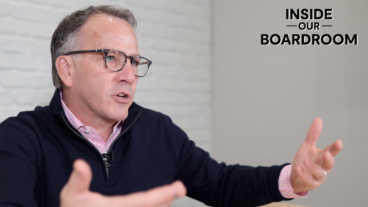Ron Tite is challenging leaders to rethink what purpose truly means in his new book, The Purpose of Purpose. For too long, he argues, businesses have treated purpose like a comforting idea instead of a catalytic force. But purpose isn’t about lofty ideals, feel good slogans, or empty promises — it’s about action, momentum, and, most importantly, unstoppable growth.
Ron is a purpose-driven leadership and marketing expert who has worked with some of the world’s most respected brands, including Google, Intel, Microsoft, Volvo, Walmart, and many others. The Purpose of Purpose is his playbook for leading with impact and creating meaningful growth that makes customers loyal, employees engaged, and competitors nervous. In his warmly contrarian style, he challenges conventional thinking about corporate purpose and uses compelling case studies, from General Motors to Lego, to illustrate how leaders can implement a true and effective purpose for transformative results.
We recently sat down with Ron to talk about his new book and delve into the true purpose of purpose and why it’s simpler than we may think.
The Problem with Purpose
Speakers Spotlight: You argue that in today’s business landscape mission-driven purpose is no longer enough — what led you to this conclusion and to explore this in your new book?
Ron Tite: There were a couple of things. First, mission-driven purpose was meant to inspire, but over time, it became more about perception than progress. Leaders wanted to sound like they cared, but their actions were inconsistent with their promises. Most importantly, true corporate purpose is strategically linked to where an organization makes money.
I was tired of companies connecting their purpose to social progress that had nothing to do with what they sold. That’s not just bad for the world, it’s bad for business. Social progress is an expectation; it’s not purpose.
Redefining Growth
SpSp: You write that “growth” should be at the heart of purpose. How do you define growth in this context?
RT: Growth isn’t just about profit; it’s about evolving in all the right ways. It’s about systems growth, people growth, efficiency growth, and sure, financial growth. When individuals grow, teams grow. When teams grow, organizations grow. That’s the kind of growth I’m talking about — the kind that uses purpose to focus internal progress. When people, systems, processes, and innovation grow, financial growth is inevitable.
SpSp: What’s one traditional belief about corporate purpose that you think needs to be retired for good?
RT: That purpose is about making the world a better place. Hear me out!
Everyone wants to be TOMS or Patagonia but VERY few organizations have any business doing it. Purpose is WHY you do something. All the other stuff — from championing human rights to acting sustainably — are HOW you behave in the pursuit of your purpose. Purpose that doesn’t directly impact how you think, do, or say things? That’s not purpose. That’s wallpaper.
Effective Purpose in Action
SpSp: You mention Lego and General Motors in your book description, what’s your favourite example of purposeful growth?
RT: The Savannah Bananas, no question. Their brand belief, “We believe there’s a better way to do almost everything” is (ahem) an inside-the-park home run. It’s guided every decision they’ve made.
I’m a big baseball fan and I was really drawn to Jesse Cole’s commitment to the purpose. The owner of the Savannah Bananas, he didn’t grow the company by leaning on baseball tradition with incremental improvements. He grew it by challenging every industry norm in his customer’s journey starting with the name and straight through every possible touch point and process. It’s a textbook case of how belief, backed by bold action, becomes growth.
Realigning Purpose with Growth
SpSp: What are some early signs that an organization’s purpose isn’t aligned with growth, and how can leaders course-correct?
RT: Well, the quick way is to complete the Brand Belief / Essential Do. In its simplest form, it’s, “We believe this SO we do this.” If yours is, “We believe that all humans are equal SO we make cargo pants”, you need to go back to the drawing board.
If the word “SO” doesn’t connect to what you believe and what you do, you’re probably pursuing purpose for PR, not growth.
SpSp: For teams that feel disconnected from high-level purpose, what’s the most important first step leaders can take to re-engage?
RT: Start by swapping the “we” for “me.” Purpose won’t resonate unless it’s personal. To do that, people need to know AND understand the organization’s (or division’s) purpose. That means communicating it with clarity. Simplicity. No jargon. But just knowing it isn’t enough. They need to know what valued and specific role they personally play in bringing it to life.
The Future of Purpose: Simplicity in Action
SpSp: How do you see the relationship between purpose and growth evolving in the next 5 to 10 years?
RT: In a previous article with Speakers Spotlight, my theme for 2025 was, “Let’s get back to work”. People will get back to work by revisiting simple models to help guide the way forward with actions, not platitudes. You don’t combat chaos with chaos, you combat it with simplicity. So, we’ll get back to intentionally driving growth — partially because we WANT to and partially because we HAVE to. We’ll want to because we we’re tired of talking about it. And we’ll have to because of tougher economic times and a disruption of the global economy.
Transform Your Organization’s Approach to Purpose
Is your organization struggling to connect purpose with performance? Ron Tite‘s thought-provoking insights can help your team reimagine what’s possible. As a globally in-demand keynote speaker, Ron delivers powerful presentations that challenge conventional thinking and provide actionable strategies to put growth at the true heart of your business.
Contact us to learn more about Ron and to book him for your next event.




